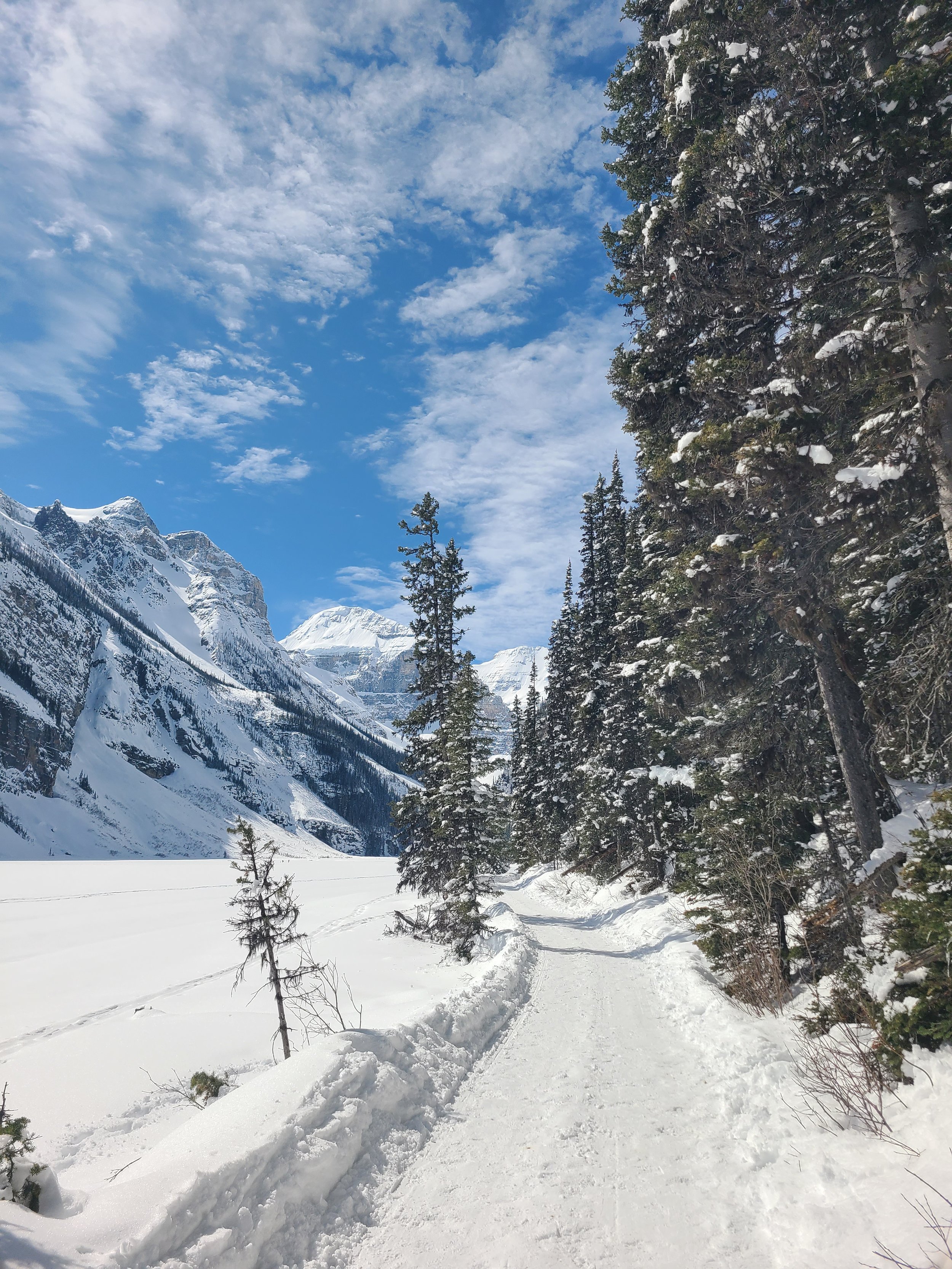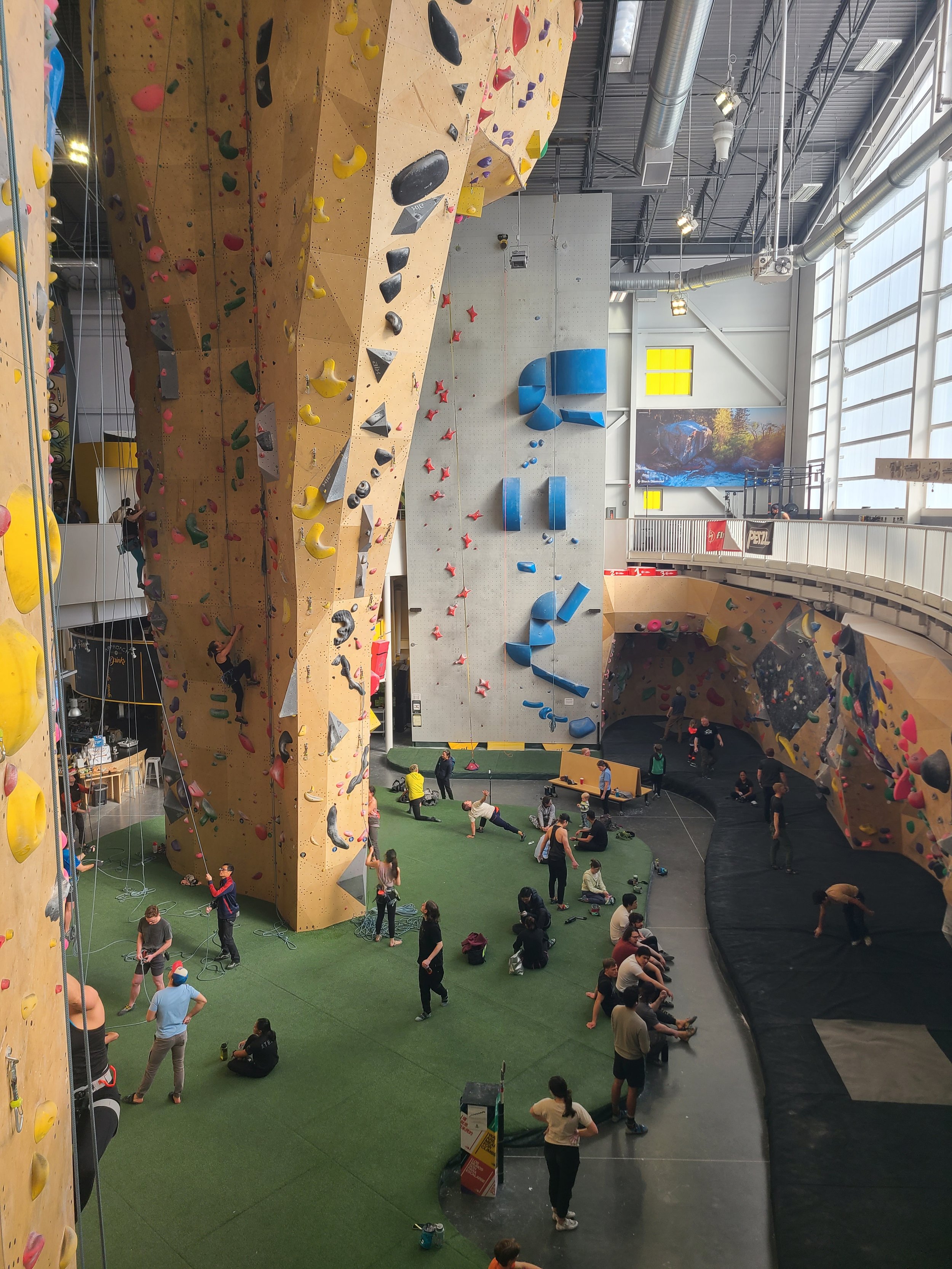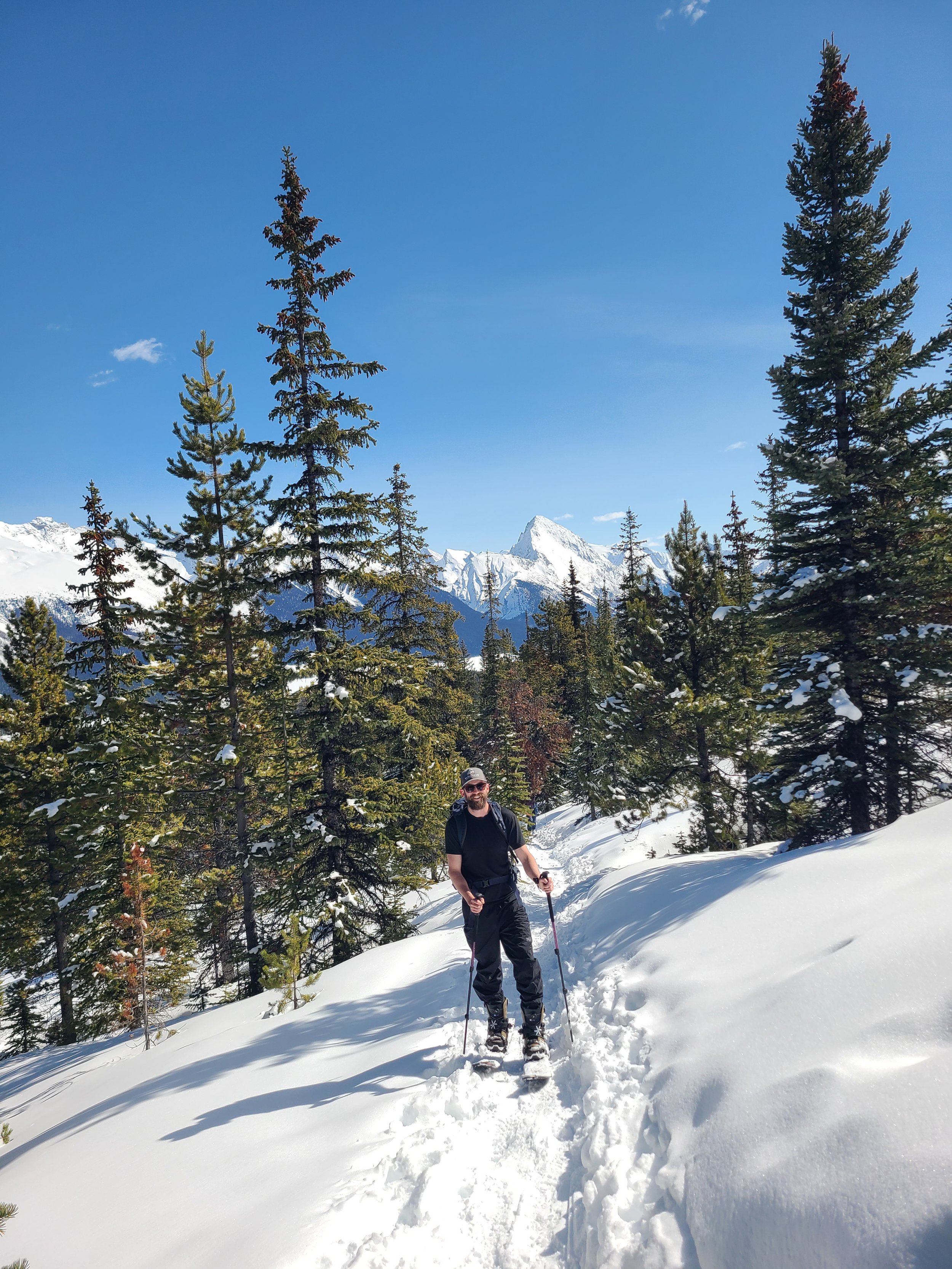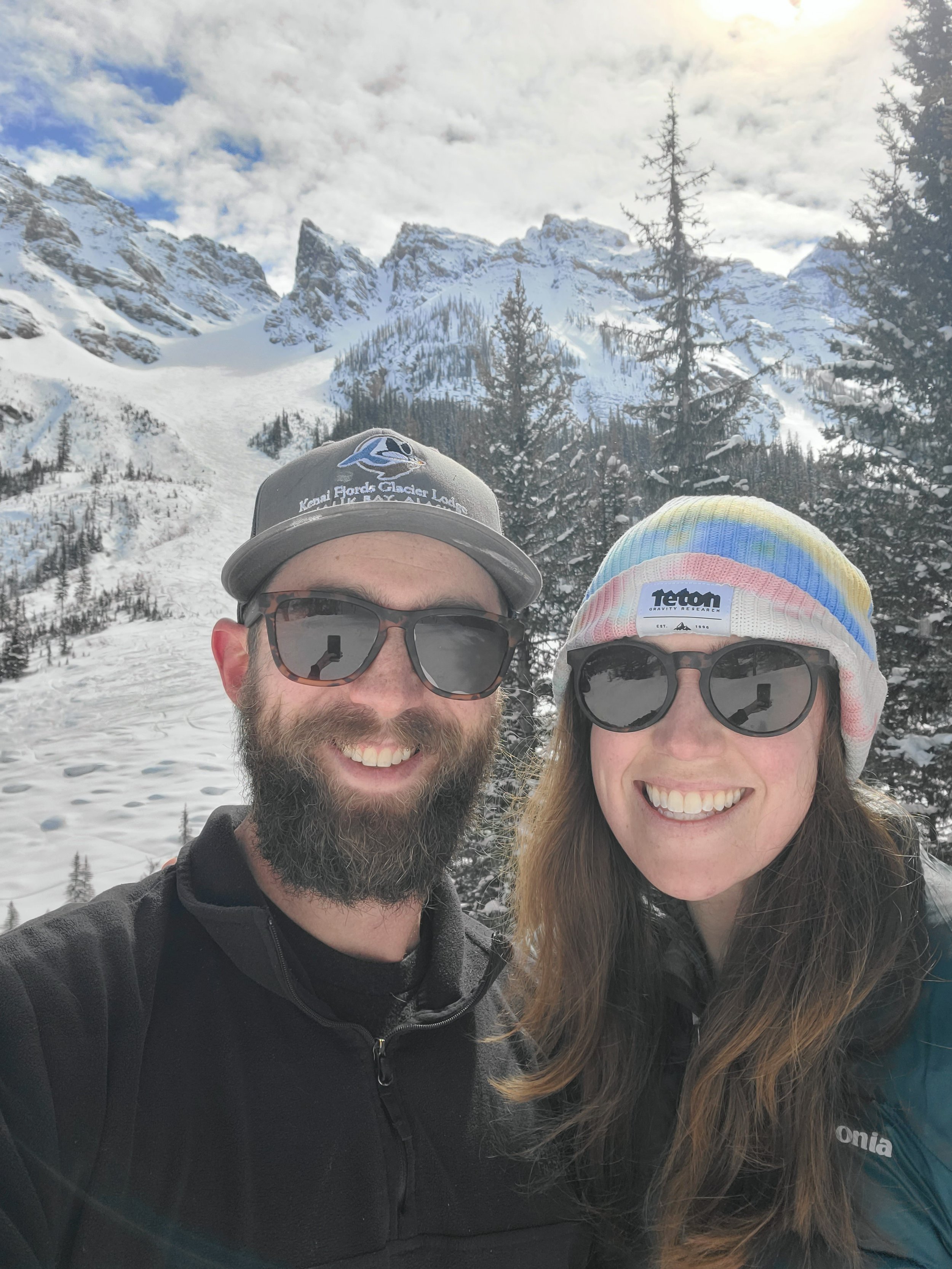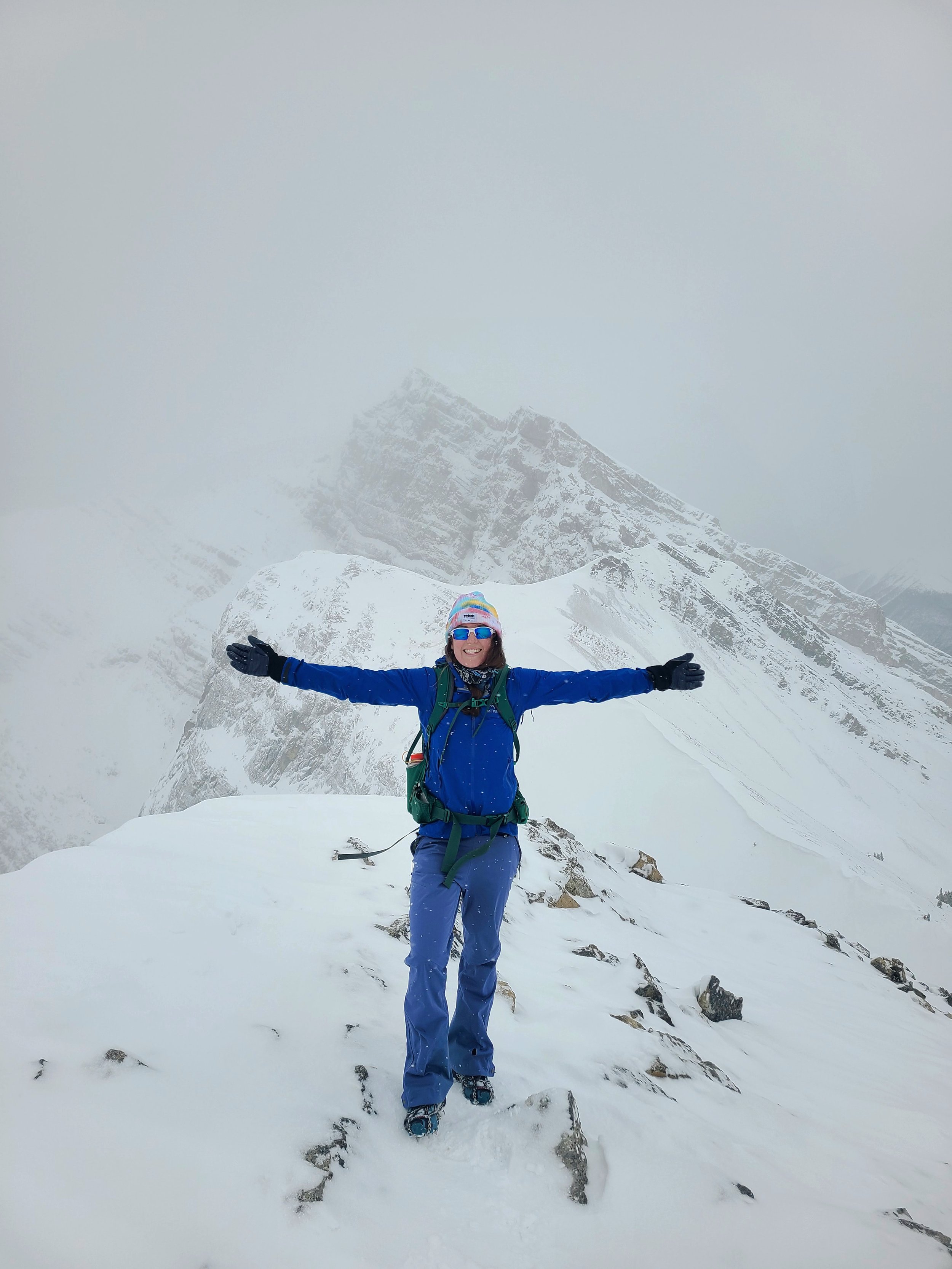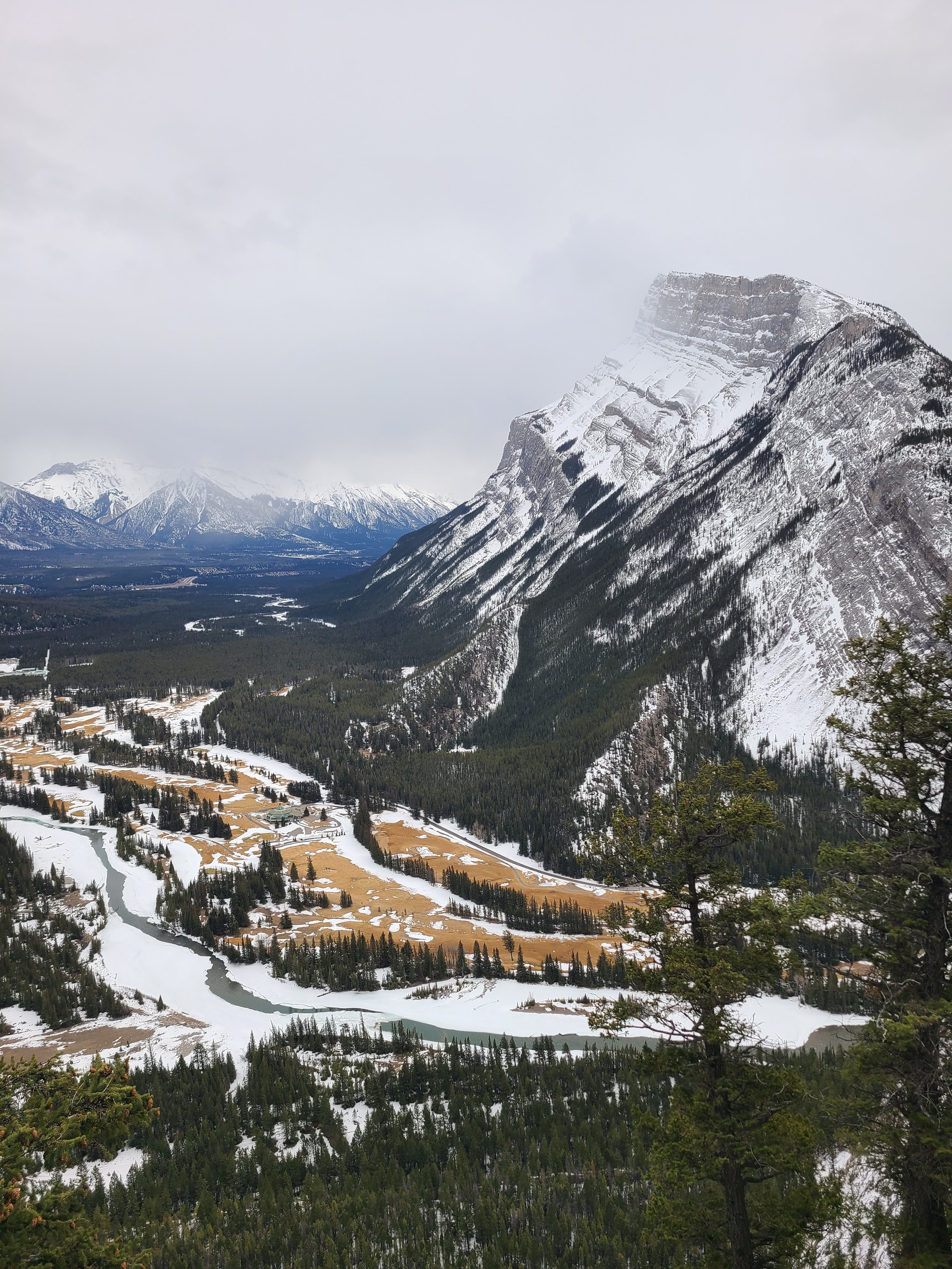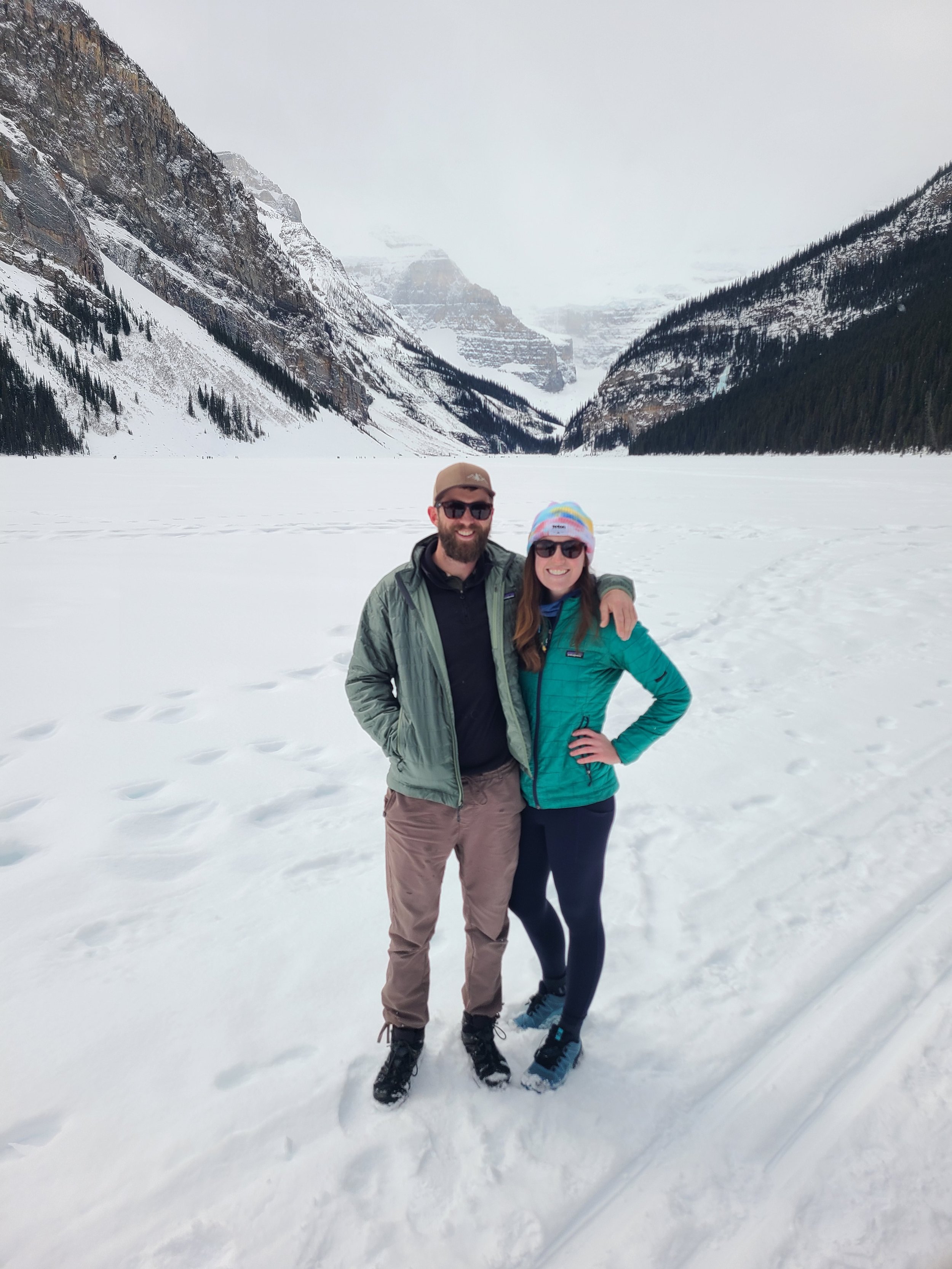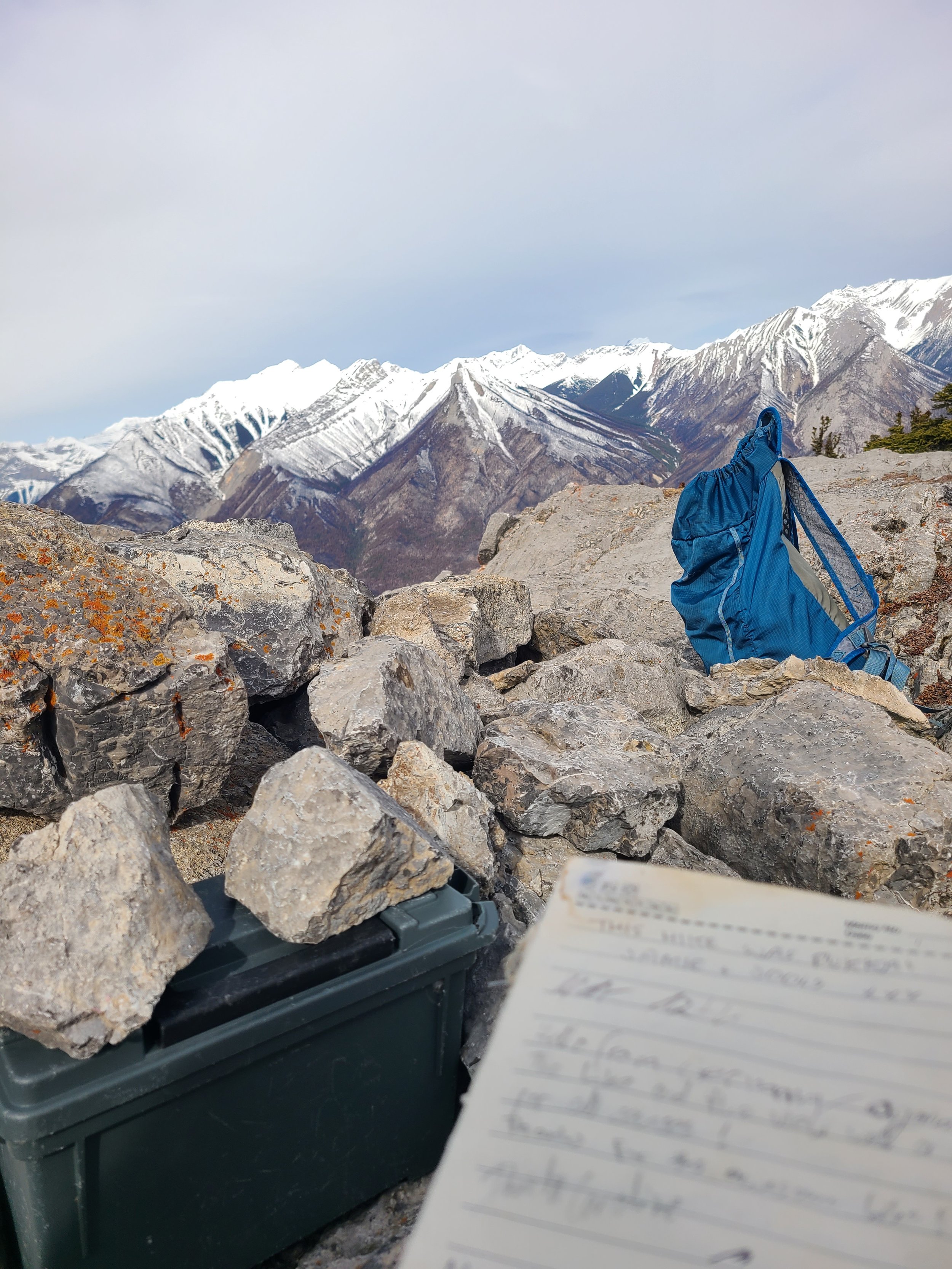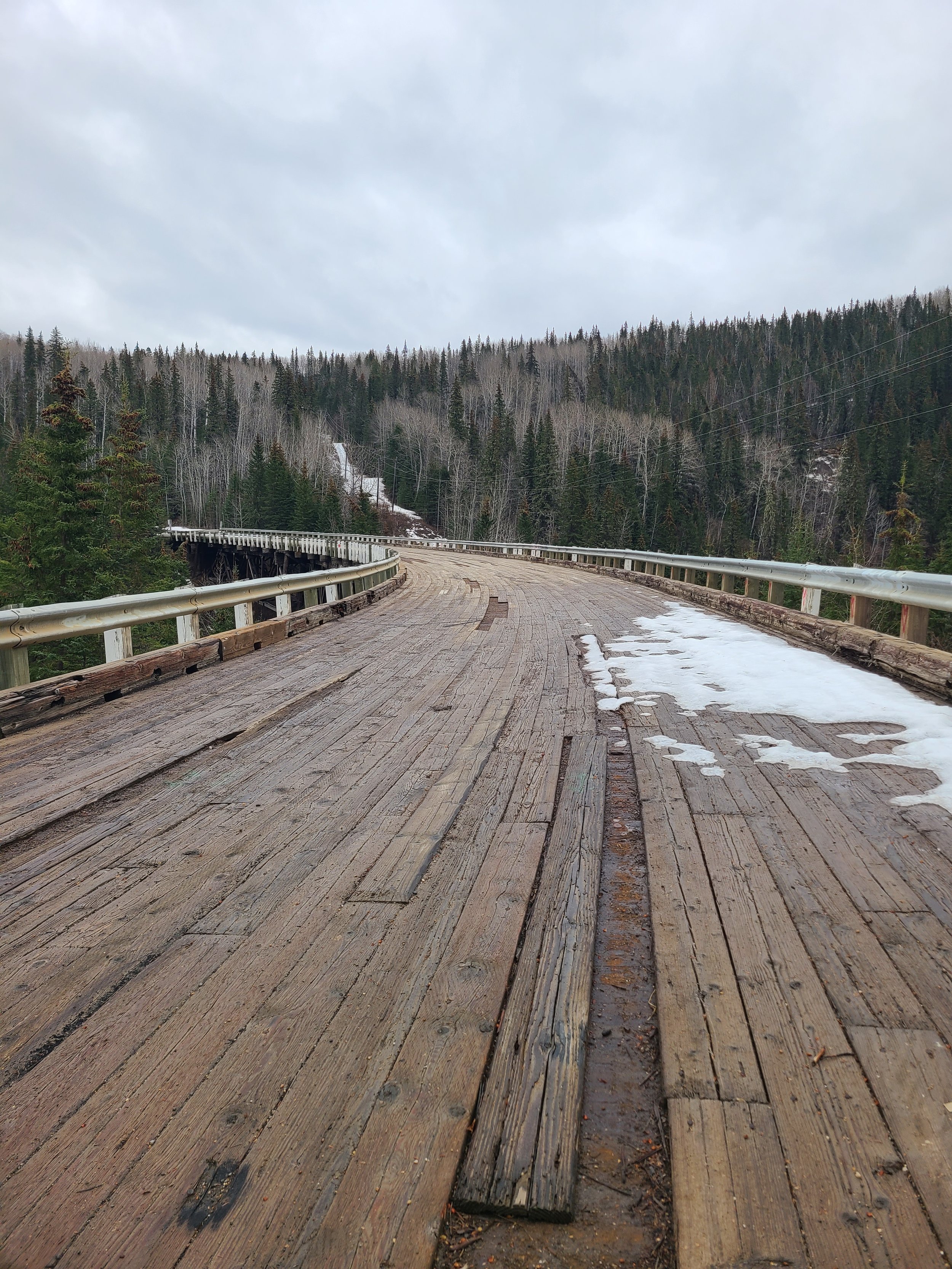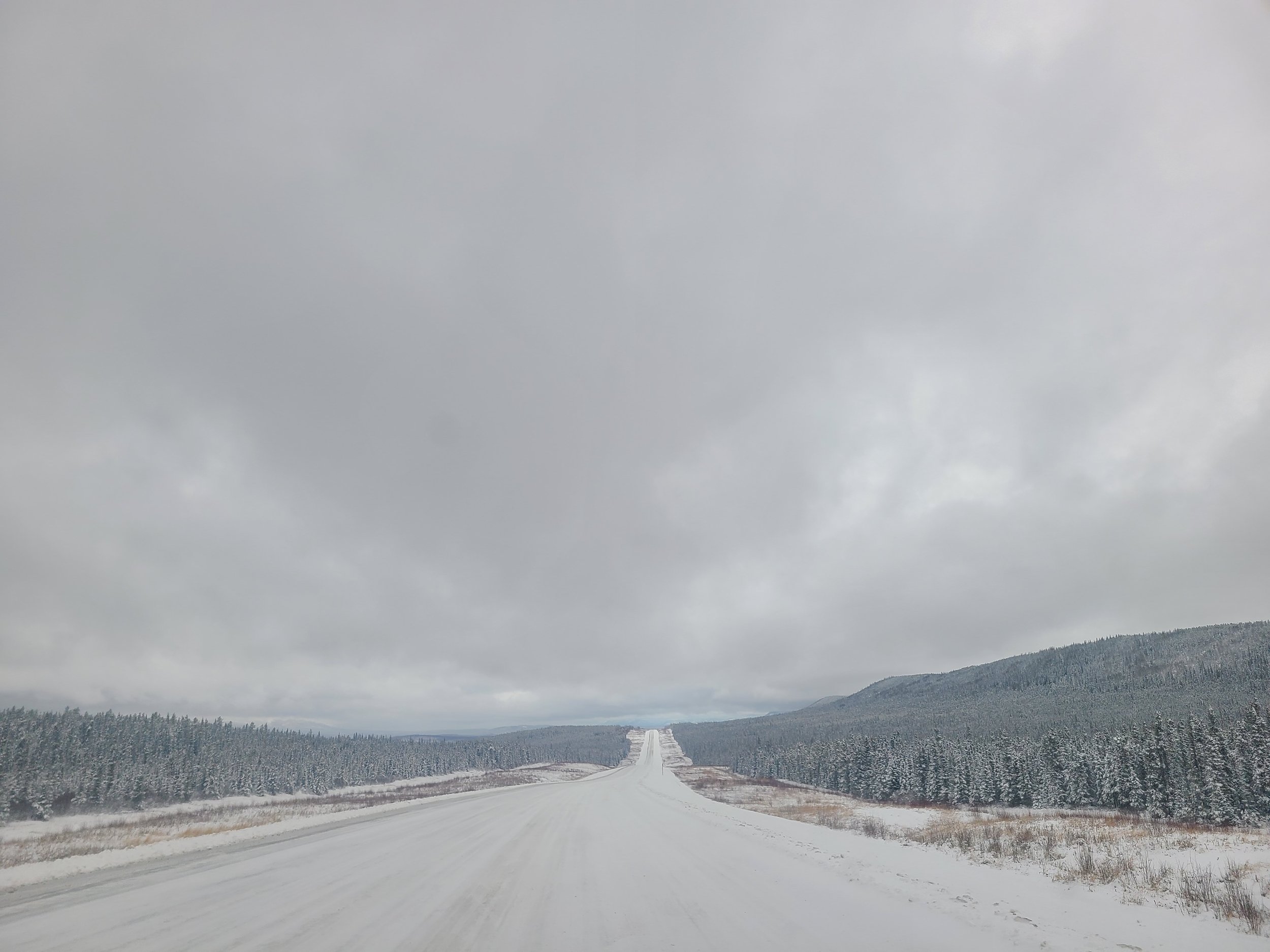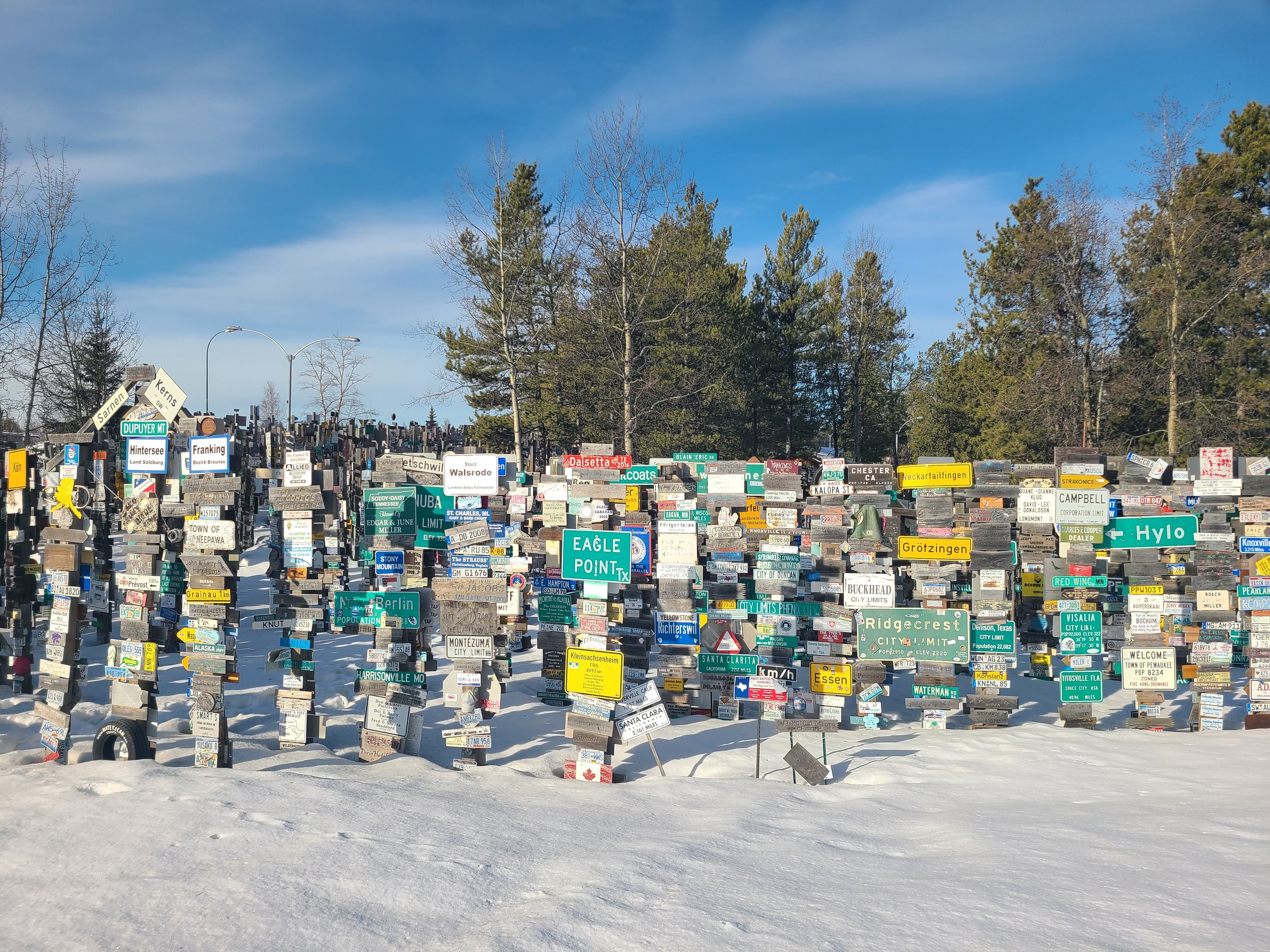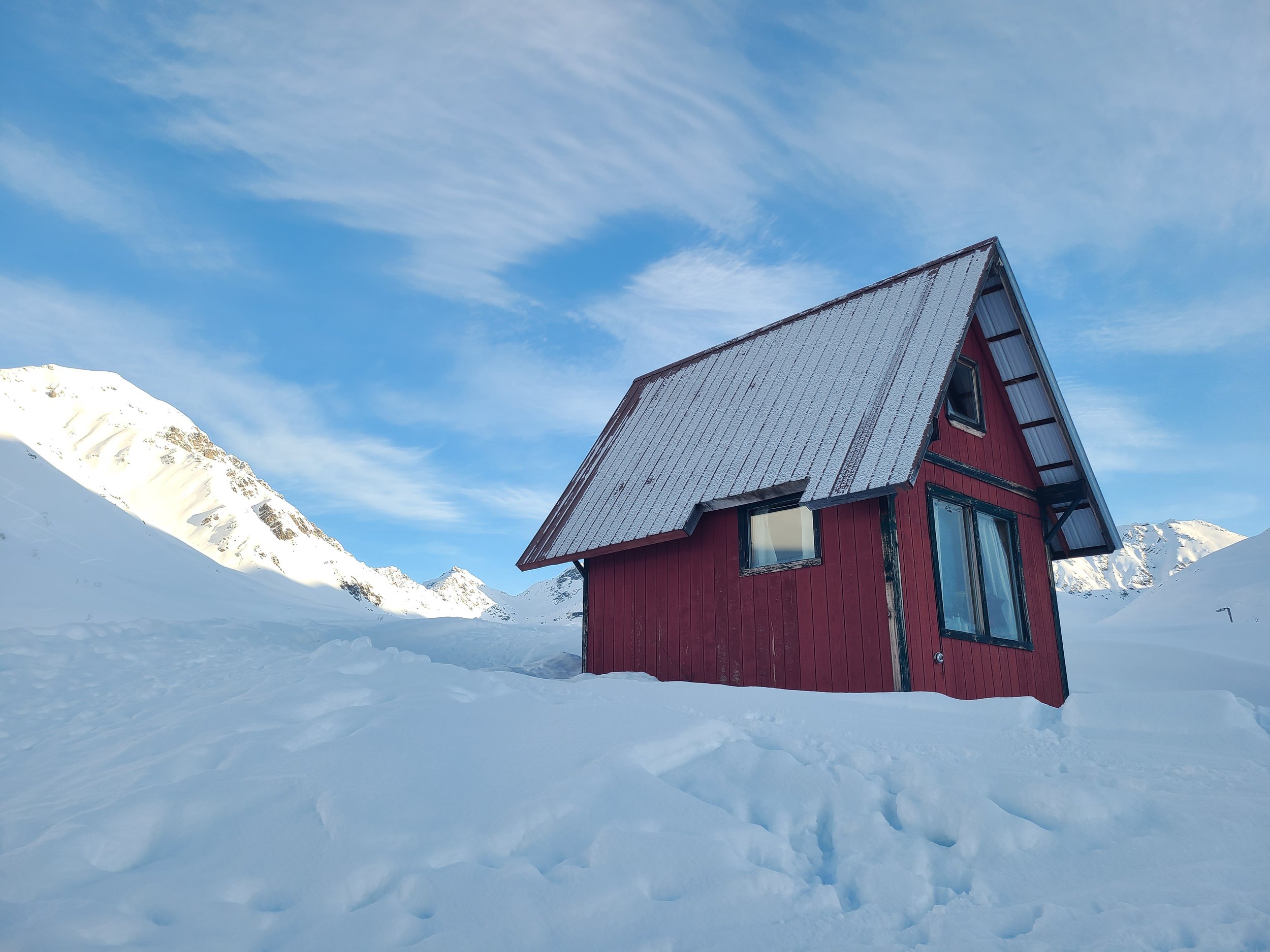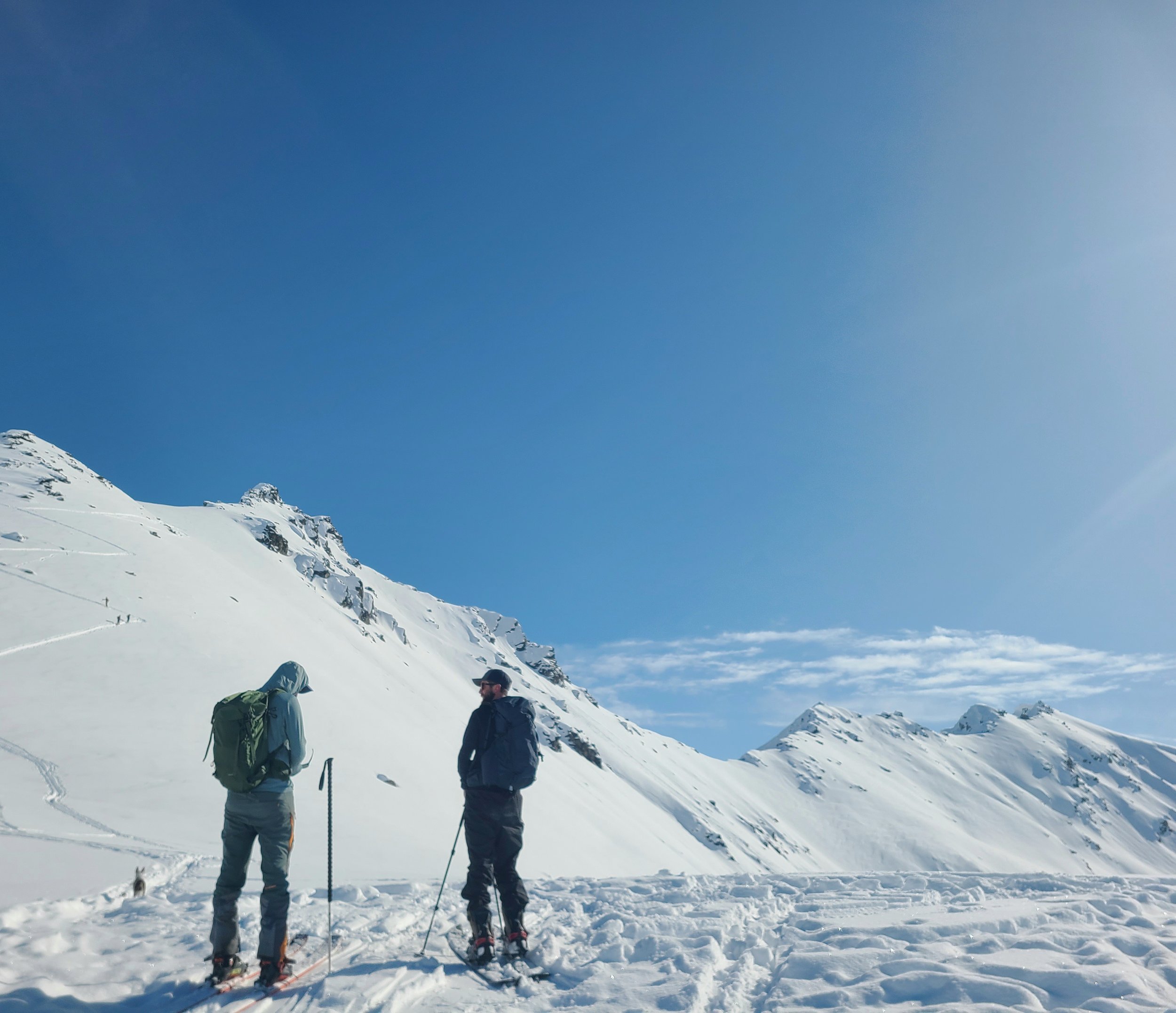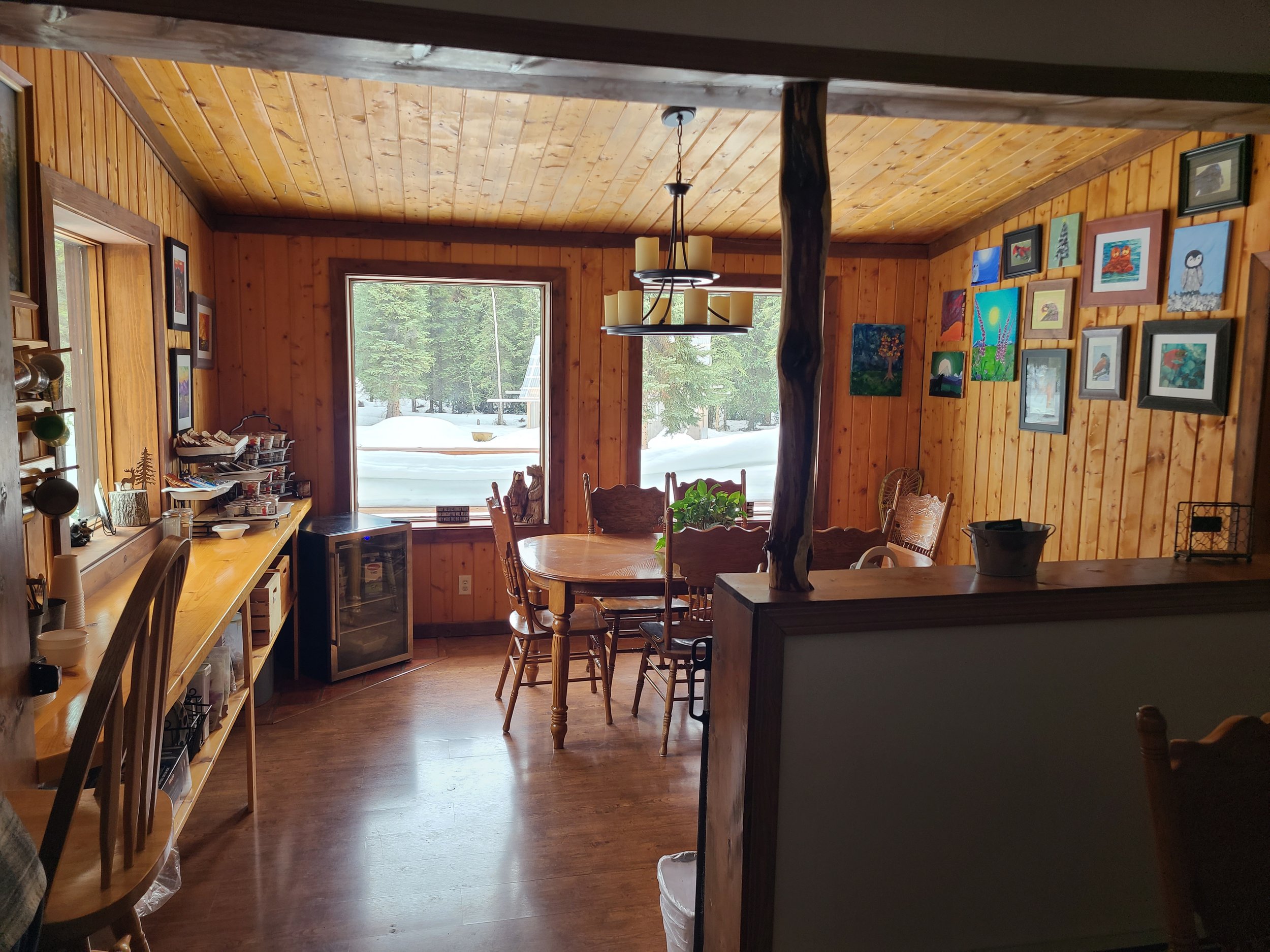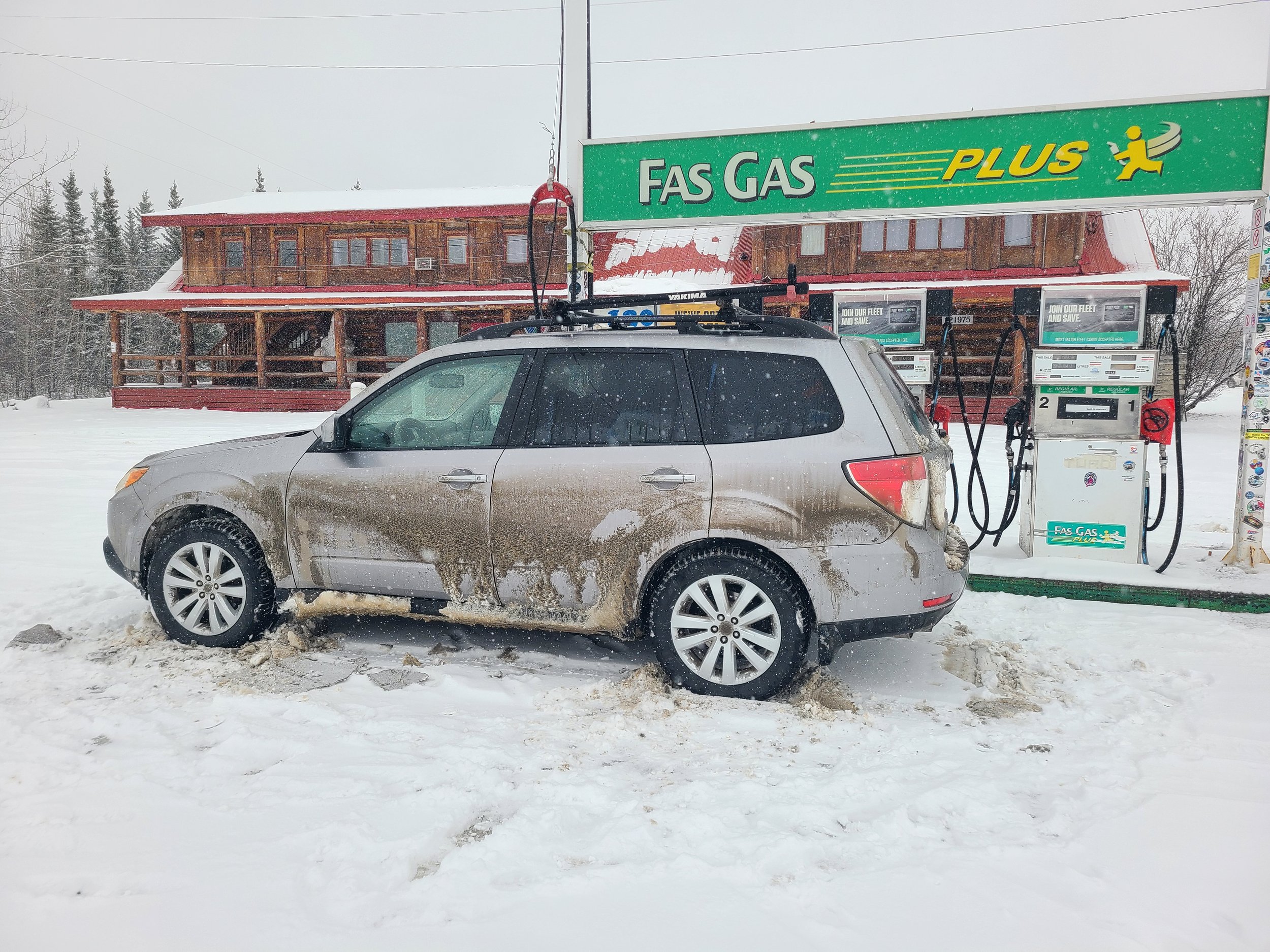A comprehensive guide to driving to Alaska from the Lower-48, the best places to stop, where to stay, and what to do along the route.
My boyfriend Nick and I have been working seasonally in Alaska for the past 4 years. He manages the guide operations for an upscale eco-lodge, and I guide 9-day hiking trips from the Kenai up to Denali. We feel very grateful to work in such a beautiful state.
After two years of flying up to Alaska (2021 and 2022), we decided we wanted to switch things up and drive from the Lower-48.
2023 was our first year driving up, and we drove again 2024. To my surprise, I discovered that I prefer the 55-hour drive to the 5-hour flight. Alaska isn’t an easy place to get to, and the road offers its own challenges. But the journey is iconic, wild, and fun. It’s all about embracing the unexpected, disconnecting the GPS, and following an old road map.
Driving to Alaska is a once-in-a-lifetime experience. I hope that everyone gets to do it at some point in their life. It’s impossible to comprehend the vastness and the beauty of the Northern landscape until you drive it. Or to understand what it feels like to be a pioneer until you are on the road driving miles upon miles. Expect snow-covered mountains, foraging fauna, patches of nothing, uncompromising wilderness, unpredictable weather, Canadian characters, cracks in your windshield, laughter, and limited services. The Alcan rarely lets you out of its rapture.
A Thinhorn Mountain Sheep smiles for his photograph in the Yukon.
But, the open road can be intimidating. And the fear of driving remote, snowy roads with limited services and wild animals prevents many travelers from taking the leap. It’s normal to be a little nervous – but with proper planning and a little flexibility, you can 100% do it.
Below, I’ve compiled a comprehensive guide to driving from the lower 48 to Alaska. This guide is based on Nick and my travels from Colorado to Alaska in March and April of 2023 and 2024. We’ve driven many remote roads (including the Dalton Highway) and have some reasonably good ideas to share based on lessons we’ve learned the hard way. I’ve included our notes on what to pack, where to stay, the best places to stop, what to eat, and what to do along the route. I hope you find it helpful and would love to hear from you if you make the trip!
Our March 2024 Travel Path: Boulder, CO → Rawlins, WY —> Driggs, ID —> Great Falls, MT, —> Calgary, AB —> Canmore/Banff/Jasper, AB —> Ft. St. John, BC —> Liard Hot Springs, BC —> White Horse, YK —> Tok, AK —> Anchorage, AK
Departed Boulder, CO: March 17th, 2024
Arrived in Anchorage, CO: April 06, 2024*
Total Miles: 3,184 miles (plus some for side trips)
Total Spent on Gas: $594.00
Total Spent on Accommodations for 2 people 21 days*: $771.00
*Note our (Itinerary includes 11 days of driving, and another 10 days of housesitting/working remotely in Calgary to break up the drive and keep our day jobs)
Before I share our day-to-day drive recommendations, I’ll answer a few quick top-of-mind questions that might come up when researching the drive.
Exploring the Athabascan Glacier on the Drive.
Should I take the Alcan or the Cassiar Highway?: If you’ve been staring at a map, you might have noticed that there are two roads to get into Alaska from Canada. The standard route is the Alaska-Canada Highway, and the other route is the Cassiar Highway, which hugs the mountains in BC to the west. The Cassiar Highway is undoubtedly more beautiful, but it is also more remote and offers fewer services. If you are driving up to Alaska during the winter or spring months (October - May), take the Alcan. It’s the smarter choice, and it is still stunning. The Alcan has fuel stops and lodges that remain open in the winter. It also passes through Whitehorse (a large town in the Yukon with mechanics and proper shops). Nick and I take the Alcan when we head up north in the spring and then take the Cassiar south in the fall.
Tell me about the Alaska-Canada Highway: The Alaska-Canada Highway (also known as the Alcan) is a 1382-mile road that connects Dawson Creek, BC to Delta Junction, Alaska. It is an impressive engineering feat, and was once described as the largest and most difficult project since the Panama Canal. By my (eyeballed) estimates, the road is 97% paved. There are relatively few services along the road. Small lodges, mom and pop gas stations, and miles of winding roads dot the landscape. Bison, coyotes, moose, sheep, goats, and bears are all possible to see along the way. Cell-service is hit or miss, but the route does pass through the large town of Whitehorse, Yukon. The highlight of this route for me is taking a dip in the Liard Hot Springs (see below for details).
What Kind of Weather Can I Expect in March and April?: Anything. Truly. Anything. April of 2023 was our first time driving up. That year, we encountered several snow storms and came across very slippery conditions. We were slammed by snow so thick that it crusted and stuck to our tire wells (see photo below), and we also had to backtrack for gas after learning that a planned fuel stop was shut down during the storm. We learned a few expensive lessons that year (to be shared in greater detail below). This year we drove up three weeks earlier in March/Early April 2024 and our drive was the complete opposite. Clear roads, blue skies, and wildlife blessed us along the way. We still hit a few patches of snow and had to slow our travels down in certain spots, but overall it was very easy driving. In short, our two years of driving were very different. Prepare for snow, but don’t worry too much. I grew up in the midwest (Chicago & Michigan), and if you can drive those Midwestern roads in the winter, you can drive the Alcan. Just take it slow and fuel up more often - services are more limited on the Alcan.
Can I camp? Or do I need hotels?: The answer to this is that it depends on the time of the year. In March and April, you might be able to camp. It’s not impossible, but it’s more challenging. Most campgrounds open on May 1st. We tried to camp twice this year but the places where we wanted to camp (Liard Hot Springs and Eclipse Hot Springs) both had feet of snow on the ground and night time temperatures hovering around 10 degrees. It’s possible that you could get a warm season. It’s also possible to camp in 10 degree weather if you have the right gear, we just chose not to. Another good option if you want to save on hotel costs is to car camp. This is doable in March and April. There are plentttty of spots along the road for car camping, and many people do it. We would car camp if our car wasn’t packed to the gill with all of our gear. In the fall, we camp on the way back down the Cassiar.
Our car after a snowy night in Tok, Alaska. 2024.
How to Prepare for Your Trip:
Get your car checked before you leave: Just do it. We learned this lesson the hard way. Go to a reliable mechanic and tell them that you are planning to drive to Alaska (in cold, snowy conditions). Get your oil changed. Have your tires, breaks, lights, frame, battery etc. checked. I promise, it is much easier (and cheaper) to fix your car in the Lower-48 than it is to fix it along the way or even in Alaska, where parts are much harder to acquire. Make sure you have four-wheel drive and snow-capable tires (we’ve seen too many small cars off the side of the road). Also be sure you have jumper cables, enough windshield fluid, and perhaps a portable tire inflator just in case. Side Note: The only thing you don’t need to replace prior to the drive is your windshield (unless of course it’s unsafe to drive with). I can almost guarantee that you will get hit by a pebble/small rock or two along the drive (resulting in a cool-looking Alaskan windshield like ours).
Bring a shovel/ice scraper- If you are driving up in the spring, it’s imperative that you are prepared for snowy conditions. Pack a shovel and an ice-chipper (and keep them in an easily accessible location). It’s likely that you will have to chip snow out of your tires. Don’t ignore this step. Having ice in your wheel wells can lead to serious (and expensive problems). In 2023, we didn’t chip the snow out of our wheel wells, which resulted in imbalanced tires, a shaking car, and the need to have the tires rebalanced ($$$).
Pick up a copy of the Milepost, an Alaskan-specific road book, or at the very least, get a road map! You’ll want to have a physical map handy because cell-service can be spotty. And it’s just cooler.
Download offline versions of the maps: Cell/internet service is not always available while traveling north, and especially on the more remote portions of the Alcan. Apps like Maps.me allow you to download offline maps that can help you navigate off the grid.
Download music & podcasts before you go - You won’t have service for large stretches of the drive (and you’ll be in Canada for most of the drive). Plan ahead and download what you need. When you are in Canada, Tim Hortons (or Timmys as the locals call it) will be your best friend for WIFI stops and coffee.
Pack extra water, food, blankets - You never know what can happen on the Alcan. We always pack a jug of water, extra food, a headlamp, toilet paper, and several warm blankets. You never know when a freak snowstorm or the urge to go could hit. It never hurts to have spare PB&J supplies as well because there are stretches of the drive with limited food options/services.
If you are planning on camping or hiking, bring bear spray - The bears are justttttt beginning to wake up in April — so it’s not unheard of to run into a recently awakened and hungry bear.
Consider bringing a gas tank - Many people carry extra gas with them just in case. During the winter months (Oct-April) fewer services are available on the road. Just because the map says there is gas ahead, doesn’t mean there is! Some fuel stops and lodges don’t open until late May. We learned this lesson the hard way our first year, when and started bringing a gas tank with us just in case. Even if you don’t bring a gas tank, fill up every chance you get (even if you are 3/4ths full).
Pack Your Passport - You will have to cross the border twice! Make sure your passport is in good standing and that you bring it along. Also, make sure you plan ahead —- certain goods aren’t allowed in Canada and vise versa - so do your research ahead of time.
Organize your gear: Traveling with a car full of gear can be overwhelming and can easily turn into a state of disarray. Pack only what you need and set up a system for where things go in the car. Everything should have a place. Items that need to be accessed frequently or that would help in an emergency should be easy to reach, and valuable items like skis or electronics should be covered by a blanket or hidden out of site.
Sitting all day is hard - plan to get some movement in: Sitting all day is the worst. Get some back support and plan to get some walking, hiking, or other activities along the way (your back, body, and bowels will thank you later). I like to do this pilates work out when I’m on the road and short on time.
Pack an old license plate — or something to contribute to the great Sign Post Forest! See DAY 08.
Day by Day - Recommendations and notes
Click the links below to expand each day of the drive. If you want to start at the Canadian border (rather than Boulder, CO where we started), zoom ahead to DAY 04.
-
Drive Time: 4 hours - easy driving
Accommodations: Hampton Inn, Rawlins. A fantastic choice! Clean, modern rooms and a good breakfast.
Notes: Try Anong’s Thai in Rawlins. We were skeptical about trying a Thai place in the middle-of-nowhere wyoming, but we can’t stop thinking about it.
-
Drive Time: 5 hours
Drive Notes: Today’s drive is beautiful. The pass from Jackson Hole to Driggs can be dangerous during snowy conditions. It has some of the steepest sloped grades in America as well in addition to a vehicle weight limit, but it’s totally gorgeous. There is also a lot of good backcountry ski access off the pass (check the avalanche report before skiing).
Notes: On the drive up, we stopped in Jackson Hole for lunch and a quick stroll around the square (however, if you’ve never been into Grand Teton National Park - drop everything and get in there). In Jackson, hit up Cowboy Coffee for a caprese sandwich and a coffee. Persephone Bakery and Cafe Genevieve also offer great local options. For beer, Snake River Brewery is a classic (sit upstairs for a quieter atmosphere) or head to Stillwest Brewery to get slightly off the main drag. For shopping, check out the new Kuhl store, the Pendleton Shop and Ringholz Art Gallery. From there, we drove over the pass to meet our friends in Driggs – and were rewarded to an epic view of the Tetons from their porch (see photo below).
Accommodations: We went to Driggs, Idaho because we wanted to visit some good friends along the drive. Driggs also happens to be an up-and-coming western town with superior views of the Tetons and a more laid-back attitude than Jackson Hole.
-
Drive Time: 5.5 hours
Drive Notes: I don’t have a ton to add for today’s drive. We stopped in Ennis for excellent sandwiches and conversation at Kaleenas. I could not resist trying it out because my middle name is Kalina. The owner was very friendly. Today you could also route through Big Sky if you wanted to ski or stop in town for lunch. That would add about 45 minutes to the drive.
Accommodations: We were lucky to stay with Nick’s cousin in Great Falls this year.
View of the Tetons from our friend’s porch near Driggs, Idaho.
-
Drive Time: 5 hours
Drive Notes: Border crossing today! Make sure you give yourself a little extra time to cross the border. In 2023, we crossed on a Saturday and waited about an hour in line. In 2024, we went through on a weekday and cruised through in 2 minutes. Have your passport ready.
Accommodations: We housesat in Calgary. We have been using Trusted Housesitters to travel for free since 2022. We housesat in Calgary for 12 days this time around, which gave us a needed break from the road and time to work remotely. See below for our Calgary notes.
-
This year, we took 10 days off to housesit in Calgary. A little over a year and a half ago, Nick and I found the best seasonal housing hack. We use a website called Trusted Housesitters to travel the U.S. and Canada, sit for some awesome pets, work remotely, and save money. We’ve stayed in some incredible homes everywhere from Naramata, BC to Boulder, Colorado and we feel like we are on one long vacation. In both 2023 and 2024, we booked housesits in Canada (in Edmonton and Calgary) to break up our drive and be able to catch up on our remote work and climb. We’ve done over 20 sits now.
Here are our top recommendations in Calgary: We went to the Rocky Mountain Calgary climbing gym every other day to boulder. They also have rope climbing, workout equipment, and kilter boards. We also enjoyed the indoor Calgary Farmer’s Market gand Last Best Brewery was phenomenal. A colleague recommended Ten Foot Henry for delicious veggie food, which I still want to try.
Other than that, we just worked, caught up on AppleTV (before we have no TV for the summer) and watched the snow fall.
-
Drive Time: 5 hours
Drive Notes: THIS IS A GREAT DRIVE. Today’s drive takes you past Canmore, Banff, and up the epic 93N highway to Jasper. Realistically, you could stop in any of these towns for the night (or however long your schedule allows) They are all great. Two things to note for this drive: You will need to buy a Banff NP pass ($20CAD) - which you can purchase at the gate. And 93N is one of my favorite roads to drive on this planet. The limestone mountains are glorious and you can see epic glaciers. Keep in mind that this road can be SLICK and remote when it’s snowy (there are no services in the winter). Double check that the road is open before you go, and make sure to fill up your gas in Banff (Lake Louise) before you get on the highway. There are no open gas stations on 93N until you hit Jasper.
Notes for Canmore: Canmore is one of my favorite mountain towns, and I would happily live here. It’s more down-to-earth than Banff, with equal access to the mountains. In 2023, we stayed at Basecamp Lodge which was an awesome treat. In town, we enjoyed bagelwiches at Rocky Mountain Bagel Company and shopping at Stonewaters (I could literally buy everything in here). Hello Vintage is also a solid stop. In 2023, we climbed Ha Ling Peak, which was unforgettably cool. The summit is no joke in the winter (so bring spikes) and full winter gear. For dinner, Rocky Mountain Flatbread is the place to go.
Notes for Banff/Lake Louise: Banff is a beautiful alpine town. It’s more touristy than Canmore, and there are a ton of shops and restaurants. I stayed at the SameSun hostel here many years ago when I was hiking with friends in Assiniboine and had a great time. Banff is definitely pricier than Canmore or Jasper, but if you’ve never been it’s worth a stroll. In downtown Banff, we hiked the short, but beautiful Tunnel Mountain Trail to a scenic overlook. Hello Sunshine allegedly has the best Ramen in town.
This year, we skipped downtown Banff and headed straight for Lake Louise to stretch our legs on the beautiful trail around the lake. Whatever you do, don’t miss a stop here. You can spend 10-minutes or a few hours on the trails behind the lake. This year, we learned that there is awesome backcountry skiing and ice-climbing just beyond the lake. We scoped the slopes and will definitely be back to ski it. (Always check the avalanche conditions first).
Optional Stop: As you drive highway 93N to Jasper, you’ll pass the Columbia Icefield, the largest icefield in the Candian Rockies. If you have time, pull over at the Athabasca Glacier stop and walk around. You won’t regret it.
Notes for Jasper: We love Jasper and chose to spend an extra day here to go ski touring. see Day 06 for our notes.
Accommodations: Mt. Robson Inn, Jasper - we love this simple, but sweet inn. It is located within walking distance of town, has a hot tub, cookies in the lobby, and serves a great included breakfast. What more is there to want?
-
Drive Time: 0 hours - (Rest Day)
Notes for Jasper: We chose to spend an extra day exploring Jasper. The park and surrounding area is very quiet in early April, and we couldn’t resist the opportunity to explore. In 2023, we hiked Maligne Canyon and Morro Peak (both excellent trails). In 2024, we went for a mellow ski tour at Bald Hills (check avi conditions before going). The views from the top of Bald Hills were otherworldly. For lunch and coffee in Jasper, we can’t get enough of Bears Paw Bakery. If you want a sandwich with an experience, head to Patricia’s Street Deli, where you’ll meet a true Canadian character and hippie slinging subs and advice. For dinner, we seem to always end up back at the family-owned greek restaurant L&W.
Accommodations: Mt. Robson Inn, Jasper - we love this simple, but sweet inn. It is located within walking distance to town, has a hot tub, and serves a good included breakfast. What more is there to want?
-
Drive Time: 6.5 hours
Drive Notes: Easy (kind of boring) driving day. But it’s the first day that you get anywhere that feels “remote.” Fuel up before you leave Jasper (or stop in Hinton before you turn onto Hwy 40) — just make sure you have enough fuel before you turn onto Hwy 40 as there are no services for 90 miles. Today also marks the first stretch on the Alaska-Canada Highway (beginning in Dawson Creek). It feels good to “start” the drive on the Alcan today. The trees get a little thinner and taller, cell service starts to die, wildlife starts to appear, and the fuel stops thin out. Note: the time changes today when you enter BC so you will gain an hour!
Places to Stop: Stop at the Kiskatinaw Bridge, located 30km north of Dawson Creek at marker 20. You’ll see a pull off that says “Old Alaskan Highway - Closed.” Take that road, and park at the base of the bridge. From there, you can walk across the impressive curved, wooden bridge that used to be a part of the Alaskan highway. It’s truly an impressive engineering feat. You can (and should) walk on it. Learn about it here. See photo below.
Notes on Fort St. John: This town feels a bit like Great Falls, Montana. It’s a working-class Canadian town. We typically use it as a resting point and don’t spend much time here. For dinner, don’t go anywhere other than the Q-spot for Sushi. It’s also worth stopping by a grocery store while you are in Fort St. John if you need to pick anything up. The next two days are low on food options and stops so it doesn’t hurt to have PB&J supplies, etc.
Accommodations: Last year we stayed at the Coast Hotel, but we 100% prefer where we stayed this year at the Ramada. The hotel looks dumpy from the outside, but has clean, modern rooms and a good breakfast.
-
Drive Time: 8 hours - slower, curvier roads.
Drive Notes: Today’s drive is gorgeous. In my opinion, the next two days are the most remote stretches of road you will encounter on the Alcan. Nick and I always text our parents to let them know that they’ll hear from us once we make it to Whitehorse. Because of the remote nature of the road here, it’s really important to pay attention to your gas today. Make sure you fill up every chance you get (even if you are 3/4ths full) or that you strap gas to the top of your car. Many of the gas stations that say they are open are not open until May 1st, so keep this in mind and don’t be fooled like we were in 2023, when we had to backtrack a full hour. Fill up your tank in Fort St. John and then again at Pink Mountain. Don’t skip a fuel up at Pink Mountain - no matter what your tank says. This year, the stretch from Pink Mountain to Fort Nelson was the snowiest/worst stretch we had. There were cars and trucks off the road, and we had to go slowly. Past Fort Nelson, the views are beautiful. Keep your eyes peeled for sheep and other wildlife.
Must-dos: No matter what you do, you need to stop for a dip at Liard Hot Springs. Don’t think twice about it, just do it. The best way to enjoy the springs is is to stay the provincial campground or at the lodge across the street (see below). The campground takes off-season bookings but does not officially open until May 1st - so camp at your own risk.
Accommodations: We were hoping to camp at the Liard Hot Springs Provincial Park, but cold weather (10 degrees F) and a recent snowstorm made us feel like getting a room in the lodge was the move. Liard Hot Springs Lodge is a delightful oasis in the middle of nowhere. They only take bookings in advance over the phone, so call while you still have service in Fort. St John. The rooms are simple. The staff is kind. The WIFI is spotty at best. And a small kitchen serves grilled cheeses and burgers with a last call at 6:45PM. Despite it’s remoteness, we always seem to run into someone we know from Alaska there. Our go-to move is to arrive, scarf down a grilled cheese, and walk over to the hot springs as the sun is setting. The hot springs are naturally crafted, and the water feels heavenly after days on the road. There is a changing room and a bathroom, but other than that it’s just you, the water, and the trees (see photo below). We always enjoy chatting with other travelers about their journeys when we are there. It’s never been crowded for us, but we are told it gets busy starting in May. You can also try to head over at night (we’ve seen some cool Aurora pictures from the pools). They are open 24/7. Note: take off all jewelry before going in the water. The minerals in the springs turn silver black for a few days.
Liard Hot Springs, Provincial Park. Early April, 2024.
Liard Hot Springs Lodge. Early April 2024.
Stretch of highway North of Fort St. John. Note the windshield cracks. Trucks will inevitably kick small pebbles up at you - wear it as a badge of honor.
-
Drive Time: 7 hours - Bison Day!
Drive Notes: This is a beautiful drive cloaked with views of the snow-covered peaks to the North and the opportunity to see Bison. Make sure you have sufficient fuel (and food) before you depart Liard Hot Springs. The Liard Hot Springs Cafe and gas pump opens at 8AM. The next spot to fuel up or grab food is at Watson Lake (and food is few and far between). We got coffee at the gas station in Watson Lake and made PB&Js in the car. Watson Lake also had a small diner and grocery store, but don’t expect anything crazy. Teslin had a few lodges open like the Yukon River Lodge (which serves breakfast and lunch). Most of the lodges on this stretch are closed until Mid-May.
Must-stops: Today, make sure you stop and say hi to at least one Bison. You’ll find them pooping and hanging out on the side of the highway. Secondly, make sure you stop at the Sign Post Forest in Watson Lake. For years, travelers have been leaving license plates and little tokens here to celebrate their arrival into the Yukon. As mentioned above, if you have a license late to spare (from your hometown or home country), it is welcome anywhere you can tack it up. See photo below.
Accommodations: In Whitehorse, we typically stay with Midnight Sun in their simple guest rooms. The company is family owned. (~85CAD/night). Ask for a room in their new complex on Strickland road. It’s newer and nicer. The rooms are attached to a communal kitchen, so you can cook a meal on your own if you want or you can head to town for a good meal.
Notes: The New York Times just awarded Whitehorse a place on its 52 places to visit in 2024 list (mainly for its aurora-viewing opportunities). I personally would not put it on my 52 places to visit list, but for a Yukon town, it’s not bad, and I do imagine the aurora show would be pretty spectacular here. Whitehorse is the biggest town you will hit while driving the Alcan. If you need anything en-route, this is the place to get it. There are large chain shops here, a main street, an airport, etc. The folks in the Yukon Visitor Center are very friendly if you have questions about anything. Nick and I like to walk along the riverfront and stop by The North End Gallery to shop for cards, earrings, mugs, and local artwork. For dinner, we recommend the Night Market, a local ramen shop that we discovered hidden in a Tim Hortons/Pizza Hut parking lot. For drinks Woodcutter’s Blanket (located in an old log cabin) seems to be the place to go. Additionally, the New York Times featured the Eclipse Nordic Hot Springs as a must-see. The hot springs are about 30-minutes outside of town. Word on the street is that they used to be called the Takhini Hot Springs and were recently purchased/renovated by a new developer. Locals think it is all very new-fangled and nice (maybe too nice? And expensive? As we sensed some annoyance from locals at the new $45CAD/entry fee). We did not get a chance to visit them, but would’ve liked to and would’ve considered camping onsite if it weren’t for the snow. For those looking for a super cool place to stay, we’ve heard good things about Black Spruce Cabins.
-
Drive Time: 7 hours
Drive Notes: Today’s drive is beautiful, but has the potential to be very snowy (especially in March/April). Every time we’ve driven it, we’ve encountered significant snow from Haines Junction through the border at Beaver Creek. Here are a few tips for today:
Fuel up in Whitehorse before you get on the road, grab breakfast, and pack a lunch. There are small gas stations/convenience stores along the drive today where you can fuel up and there is a small diner in Haines Junction, but there really isn’t anything substantial to eat until Tok, Alaska (also a small town with limited services/food). Tok is pronounced “Toke.”
Keep an eye on your wheel wells and be sure to chip any accumulated snow off of your tires. This is the day when your ice-scraper and shovel will come in handy. Note: If you don’t chip the snow out of your wheel wells, you might make the same mistake we made year one. Heavy snow on tires causes them to become imbalanced. If this happens your car will start shaking and you will need to either replace your tires or get them rebalanced. Stay a step ahead and save on a costly repair by chipping the snow out of your wheel wells before it freezes.
Accommodations: Fox n’ Fireweed is our favorite place to stay in Tok (and on the entire drive). It’s homey. Comfortable. Quiet. And very Alaska. The walls are wood paneled, there is a mug rack that I dream of recreating one day, and it’s so peaceful. They offer simple but nice rooms in a shared house as well as cabins (summer months only). We always stay in the main house in either the Lynx or Wolf room. It’s a peaceful retreat for us, and I can’t imagine coming or going from Alaska with out stopping here. It feels like the lobby to Alaska. We typically bring food from the grocery store to cook in the communal kitchen here, however, Tok has decent food at Fast Eddys and a Three Bears Grocery Store.
-
Drive Time - 5-6 hours (You’re there!)
Drive Notes: Today is your victory lap! You made it to Alaska! If you are lucky and the skies are clear, you may be able to catch glimpses of Mt. Sanford in the Wrangells or even Denali up North. Enjoy the stunning drive.
Places to Stop: We typically stop at Vagabond Blues in Palmer, Alaska for lunch and coffee.
Accommodations: Typically we stay in airbnbs in Anchorage or at the Highliner Hotel. This year, we made a last minute change of plans when our friend invited us up to a cabin at Hatcher Pass Lodge, a 30-minute detour into the Talkeetna range. This last minute change of plans ended up being so worth it and was the perfect “welcome back” to Alaska. The lodge offers simple A-frame cabins (that overlook the STUNNING snowcapped Talkeetna mountains). There is a fun cafe with live music on weekends. We got to see Wiley Post play while snow fell around us! In the morning we ski toured up the mountain from the parking lot. I HIGHLY recommend a trip to Hatcher Pass Lodge. See photo below.
A bad wheel-well situation in 2023, that caused our tires to become imbalanced and the car to shake! Learn from us, and make sure you chip the snow out of your wheel wells frequently!
My favorite mug wall at Fox N’ Fireweed in Tok, Alaska
Long story short, the drive to Alaska is nothing short of amazing. It is rough, wild, and vast. I hope that this guide has been helpful, and I would love to hear about your adventures up to the Greatland.
In the meantime, I invite you to follow me on instagram @ckvanw and @clairekalinadesigns or to check out my fabric and wallpaper offerings on Spoonflower. I have a number of cool design projects in the works for Alaskan companies and am looking forward to another summer guiding trips up here.







